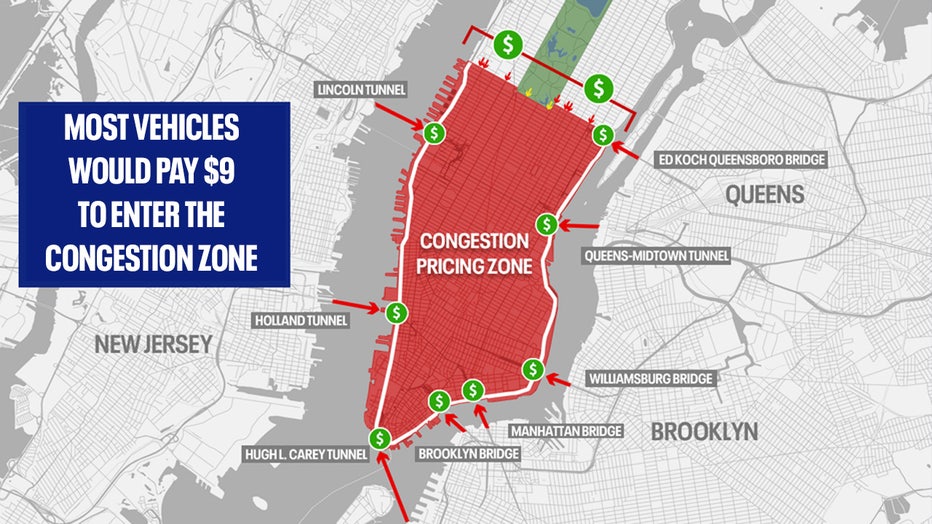30 days of NYC congestion pricing: What the numbers show

NY Republicans, Trump talk NYC congestion pricing
New York Republicans say they have faith that NYC congestion pricing won't last long following a meeting with President-elect Donald Trump. FOX 5 NY's Hayley Fixler has the story.
NEW YORK - Congestion pricing turns one month old this week, and so far, it appears to be having an impact.
Last week, MTA officials reported a noticeable drop in congestion since the pricing plan took effect in early January.
But the policy’s future remains uncertain.
The New York Times reports that the Department of Transportation is discussing whether to withdraw a key federal authorization that the tolling plan received from the Biden administration last year. No final decision has been made, but President Donald Trump has remained adamant about halting congestion pricing.
Can Trump axe Congestion Pricing?
Trump may be watching Governor Kathy Hochul’s congestion pricing plan more closely than expected. According to a source familiar with the matter, Trump and Hochul spoke twice last week, discussing a range of issues, including New York City's congestion pricing.
By the numbers:

NYC congestion pricing, Mayor Adams: What's new?
FOX 5 NY's Morgan McKay has the latest updates on congestion pricing in New York City, as well as Mayor Eric Adams.
The MTA reported that since the congestion pricing plan was launched on Jan. 5, more than 1 million fewer vehicles have entered the Congestion Relief Zone (CRZ) than they would have without the toll.
Since the launch of congestion pricing, the MTA has reported that an average of 490,000 vehicles enter the CRZ daily, while an additional 63,000 travel through the Central Business District (CBD) using toll-exempt roadways.
TRANSCOM provided data to the MTA saying how drivers have been experiencing much faster commutes.
What they're saying:
- Inbound trip times on all Hudson and East River crossings are now 10% to 30% faster or more than they were in January 2024.
- Drivers crossing via the Holland Tunnel are experiencing the most improved daily time crossings, with a 48% reduction on average during peak morning hours.
- The Williamsburg and Queensboro Bridges are both experiencing an average of 30% faster trip times.
- Drivers on the Long Island Expressway, Flatbush Avenue, NJ 495 and other roads leading up to crossings have been seeing improved speeds.
Data from TRANSCOM also showed that drivers in the CRZ are experiencing travel time improvements especially during afternoon peak hours with reductions as high as 59%.
Who is entering the Congestion Relief Zone?

NYC congestion toll inspires sales of illegal kits
Law-evading drivers can buy devices that obscure license plates online. The $60 kits allow drivers to get away with speeding, evading tolls and skirting congestion zone fees.
Data from the MTA shows that the majority of those entering the CRZ (57%) are passenger vehicles. Here's what other vehicles are entering the city:
- 36% of entries are taxis and for-hire vehicles.
- 4% of entries are small trucks.
- 0.5% of entries are large trucks.
MTA buses: Riders on express buses from Queens, Staten Island, and the Bronx are saving up to 10 minutes on average travel time, the MTA said.
- Bus ridership is growing with express weekend ridership seeing a 21% bump in ridership and 7% growth on non-express routes.
- Weekday express bus ridership is up 6% over January 2024.
- Ridership on the X27 bus route from Bay Ridge to Manhattan grew by nearly 15% on weekdays and 55% on weekends.
MTA subway: The MTA found that subway ridership has also grown by 7.3% on weekdays and 12% on weekends when comparing January 2024 and January 2025.
LIRR: The MTA reports that in January, ridership at New Hyde Park, Douglaston, Garden City, Ronkonkoma, and Woodmere stations surged ahead of the overall Long Island Rail Road growth compared to last year.
What is congestion pricing?
What we know:

Congestion pricing is an electronic tolling system that charges vehicles for entering Manhattan's Congestion Relief Zone (CRZ) — the area below 60th Street, excluding certain highways like the FDR Drive and West Side Highway. The program aims to:
- Reduce gridlock in Manhattan's busiest areas.
- Encourage public transit use.
- Fund approximately $15 billion in transit infrastructure improvements.

